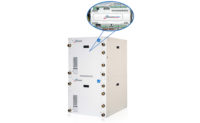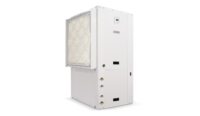Responding to customer requests for a geothermal solution for K-12 education buildings, Trane now offers a single chiller option for its central geothermal system.
The single chiller option optimizes efficiency and sustainability in environments that need to address cooling loads of 80 to 250 tons, a load common in K-12 school buildings.
Geothermal systems use the earth’s renewable thermal energy for heating and cooling. These systems can generate significant operating cost savings and reduce carbon emissions.
According to a 2000 Oak Ridge National Laboratory study of geothermal heat pumps (GHPs) in K-12 schools in Lincoln, Neb., new schools incorporating GHPs use 26 percent less source energy per square foot than new schools without GHPs.
This solution can improve more than energy savings and air temperature-it also can enhance the environment for learning whichcan actually affect student performance. A recent study in Educational Facility Planner Reportfound a direct correlation between the environmental conditions in classrooms and student performance.
Compared to traditional GHPs, the central geothermal system from Trane offers increased energy efficiency, reduced noise, increased air cleaning options and centralized maintenance.
The Trane system combines the energy efficiency of geothermal with the benefits of a centralized heating, cooling and air handling system to provide an even more efficient and comfortable solution than traditional geothermal systems. For ease of use, all major equipment is centrally located in the mechanical room.
“Particularly in the Midwest, East and Canada, our customers told us they wanted a very efficient geothermal solution that meets the needs of their K-12 school buildings,” said Randy Newton, global leader of applied systems at Trane. “This system allows them to use energy from the earth to increase energy efficiency while optimizing the learning and teaching environment.”Several factors are driving school leaders to consider geothermal solutions, especially the reduced operating costs they offer. Also some states and many utility companies offer rebates for schools, nonprofits and other organizations that use geothermal systems, which improves the return on investment for the owner.
Although Leadership in Energy and Environmental Design (LEED) certification does not require the use of geothermal solutions, schools using them can expect to gain LEED energy credits toward certification. These incremental credits are achieved through an efficiency percent increase comparing geothermal to a baselined ASHRAE 90.1 guidelined system.
Get our new eMagazine delivered to your inbox every month.
Stay in the know on the latest HVACR engineering trends.
SUBSCRIBE TODAY!Copyright ©2024. All Rights Reserved BNP Media.
Design, CMS, Hosting & Web Development :: ePublishing


